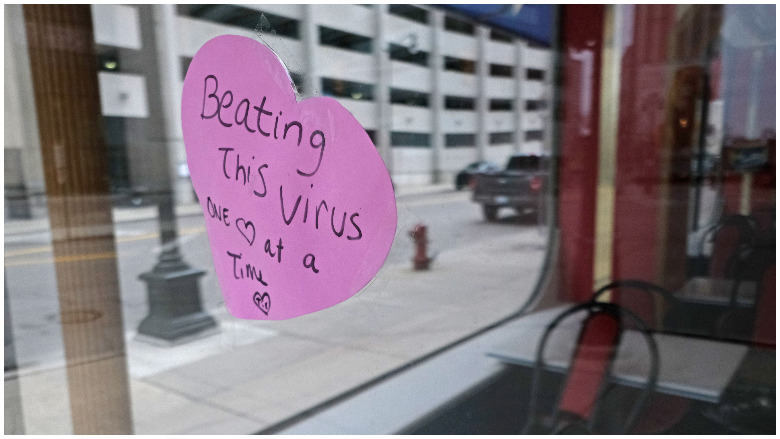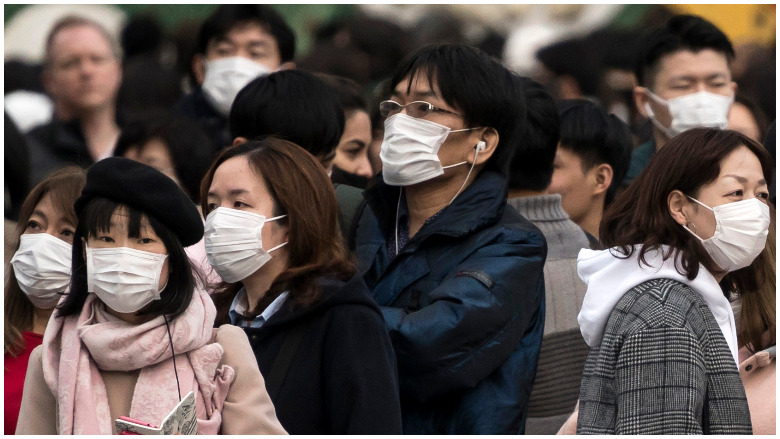
Getty
Even if you’re self-quarantining from coronavirus, there’s a limit to how little contact you can have with the outside world. After all, you have to eat. Unless you’re sitting on a massive stockpile of food (and household supplies), you’re going to have to get groceries eventually. Maybe you do that through delivery. Maybe you pick it up outside the store. Maybe you’ve cautiously ventured into the store, keeping social distancing rules intact.
Even the most cautious may wonder, though: How can you sanitize groceries to protect yourself and your family from coronavirus (COVID-19)? Should you? The Environmental Protection Agency has released a list of cleaners and disinfectants that destroy COVID-19; you can find the list later in this article. You could clean grocery items with them (say the outside of cans or harder packages), just make sure that you don’t contaminate any food items (you wouldn’t want to put Clorox on fruit for example; we’re talking about the outside of packaging, such as cans).
One expert, Dan Schaffner, a professor of food microbiology at Rutgers School of Environmental and Biological Sciences, told Vox that he thinks disinfecting your groceries is “being overly cautious” because there are no known cases of COVID-19 being transmitted by food or its packaging. However, we know some people are doing it anyway just to be safe. Some people remove the grocery items from their store packaging and put them in Tupperware or other storage items that they have at home or they wipe the items down.
Another expert, Dr. Jeffrey VanWingen, MD, has prepared a YouTube video on exactly this topic. He pointed out that risk comes with “movement.” He borrowed from a medical term called “sterile technique,” which is used in surgeries, and adapted it to grocery shopping. He suggests not using groceries for three days and leaving them in the garage; having a delivery person leave them outside is better. You want contact-free delivery. If you go to the store, wipe down your shopping cart. Stay away from the store if you have signs of respiratory illness, and don’t let people over age 60 shop. Get two weeks of groceries and minimize your time in the store. Once you get the groceries home, sanitize your workplace. Put the groceries on the non-clean side of the table and systematically sanitize them with disinfectant wipes. Wipe down bottles. With items like cardboard cereal boxes, get rid of the box. Cloth bags increase risk and should be consider dirty; put them outside after use. This is all according to Dr. VanWingen. He suggests washing fruit with soap and water for 20 seconds as if it’s your hands.
He said you should imagine the groceries are covered with glitter and strive to get no glitter on you, especially on your face.
More importantly, it’s a good idea to limit contact with people, because the virus generally spreads through respiratory droplets. That includes the person delivering the groceries, other shoppers or the person checking you out.
The U.S. Food & Drug Administration wrote, “… the U.S. food supply remains safe for both people and animals. There is no evidence of human or animal food or food packaging being associated with transmission of the coronavirus that causes COVID-19.” The FDA added, “Unlike foodborne gastrointestinal viruses like norovirus and hepatitis A that make people ill through contaminated food, SARS-CoV-2, which causes COVID-19, is a virus that causes respiratory illness. This virus is thought to spread mainly from person to person. Foodborne exposure to this virus is not known to be a route of transmission.”
If you have a reusable bag, wash it when you get home, or use bags you can quickly throw away. Schaffner downplayed this too in an interview with Wirecutter. “While it is theoretically possible that a reusable bag may pick up germs, including coronavirus while in the grocery store, the biggest threat that anyone faces is someone else in the store who has COVID-19,” he told the publication. Still, it’s a precaution you could take. He does suggest frequent hand washing, including after coming back from the store. Wirecutter suggests not using groceries (if they’re not perishable) for three days because the virus will be unlikely to survive that long.
How should you launder a reusable grocery bag? The CDC advises, “Launder items as appropriate in accordance with the manufacturer’s instructions. If possible, launder items using the warmest appropriate water setting for the items and dry items completely. Dirty laundry from an ill person can be washed with other people’s items.”
Syracuse.com suggests that using wipes on a cart in a store is more important than wearing gloves, which can transmit coronavirus. “Keep a distance of two grocery carts between yourself and other shoppers,” the site says. Avoid touching your face, and use something like Apple Pay. This site suggests not using soap or diluted bleach on produce.
Experts told Vox that you should also minimize how much you’re shopping; opt for once every week or two weeks, not every other day. The site also suggests that you shop at off-peak hours when there are likely fewer people in the store.
Again, due to the manner in which the CDC believes coronavirus commonly spreads, people are your biggest danger so choose grocery shopping methods that minimize interaction with them. Bag your own groceries if you must go in person. If you must interact with people, maintain the at least six-foot social distancing rule. You also don’t need to drag the entire family, including children, along. Make a list and shop with a purpose, rather than ambling around the store impulse buying. Get in and get out, if you feel you must go (there’s a risk).
As for produce, the FDA also recommends, “Wash all produce thoroughly under running water before preparing and/or eating, including produce grown at home or bought from a grocery store or farmers’ market. Washing fruits and vegetables with soap, detergent, or commercial produce wash is not recommended.”
Here’s what you need to know:
Coronavirus can Live on Objects & Surfaces, So Sanitizing Grocery Items Is Not a Bad Idea

GettySecurity guards patrol outside the Huanan Seafood Wholesale Market where the coronavirus was detected in Wuhan on January 24, 2020.
The Centers for Disease Control & Prevention does say that coronavirus may possibly spread through objects, but this is not believed to be the main way that it spreads.
“The virus that causes COVID-19 seems to be spreading easily and sustainably in the community in some affected geographic areas,” CDC notes.
A recent study found that “viable virus could be detected in aerosols up to 3 hours post aerosolization, up to 4 hours on copper, up to 24 hours on 36 cardboard and up to 2-3 days on plastic and stainless steel … Our results indicate that 40 aerosol and fomite transmission of HCoV-19 is plausible, as the virus can remain viable in aerosols for 41 multiple hours and on surfaces up to days.”
VanWingen pointed out that officials found coronavirus particles in a cruise ship 17 days later, so some of the research on this is conflicting.
The Centers for Disease Control and Prevention has an entire page devoted to how coronavirus spreads. The CDC says:
The virus is thought to spread mainly from person-to-person.
Between people who are in close contact with one another (within about 6 feet).
Through respiratory droplets produced when an infected person coughs or sneezes.
These droplets can land in the mouths or noses of people who are nearby or possibly be inhaled into the lungs.
The CDC does add, though: “It may be possible that a person can get COVID-19 by touching a surface or object that has the virus on it and then touching their own mouth, nose, or possibly their eyes, but this is not thought to be the main way the virus spreads.”
The Centers for Disease Control and Prevention says that there is currently no evidence to support transmission through food, however (but that wouldn’t apply to food containers or cans):
Coronaviruses are generally thought to be spread from person-to-person through respiratory droplets. Currently there is no evidence to support transmission of COVID-19 associated with food. Before preparing or eating food it is important to always wash your hands with soap and water for 20 seconds for general food safety. Throughout the day wash your hands after blowing your nose, coughing or sneezing, or going to the bathroom.
It may be possible that a person can get COVID-19 by touching a surface or object that has the virus on it and then touching their own mouth, nose, or possibly their eyes, but this is not thought to be the main way the virus spreads. In general, because of poor survivability of these coronaviruses on surfaces, there is likely very low risk of spread from food products or packaging that are shipped over a period of days or weeks at ambient, refrigerated, or frozen temperatures.
The EPA Has Published a List of Cleaners That Kill Coronavirus

Getty
If you’re looking to sanitize groceries, make sure you turn to cleaners that are known to be effective in killing coronavirus (just make sure they don’t contaminate your food).
The United States Environmental Protection Agency has released an expanded list of disinfectants and cleaners that destroy COVID-19. In addition, the Centers for Disease Control and Prevention has a simple recipe for a bleach and water mixture that kills the virus.
Authorities say that cleaning and disinfection matter a lot because the virus spreads through respiratory drops and can live on surfaces. The new EPA list is known as “List N.”
“When purchasing a product, check if its EPA registration number is included on this list. If it is, you have a match and the product can be used against SARS-CoV-2. You can find this number on the product label – just look for the EPA Reg. No. These products may be marketed and sold under different brand names, but if they have the same EPA registration number, they are the same product,” the EPA states.
You can find the full list here.
“This list includes products with emerging viral pathogen claims and those with human coronavirus claims. If a product with an emerging viral pathogen claim is not available, use a product with a coronavirus claim. If the product is listed as ‘N’ under the Emerging Viral Pathogen Claim column, then it has a human coronavirus claim,” EPA states, noting, “Inclusion on this list does not constitute an endorsement by EPA. There may be additional disinfectants that meet the criteria for use against SARS-CoV-2. EPA will update this list with additional products as needed.”
There are more than 270 entries on the EPA’s list.
The CDC adds: “Community members can practice routine cleaning of frequently touched surfaces (for example: tables, doorknobs, light switches, handles, desks, toilets, faucets, sinks) with household cleaners and EPA-registered disinfectants that are appropriate for the surface, following label instructions. Labels contain instructions for safe and effective use of the cleaning product including precautions you should take when applying the product, such as wearing gloves and making sure you have good ventilation during use of the product.”
Here’s the EPA’s previous list of “Registered Antimicrobial Products for Use Against Novel Coronavirus SARS-CoV-2, the Cause of COVID-19.” Explains CDC, “Products with EPA-approved emerging viral pathogens claimspdf iconexternal icon are expected to be effective against COVID-19 based on data for harder to kill viruses. Follow the manufacturer’s instructions for all cleaning and disinfection products (e.g., concentration, application method and contact time, etc.)” (Note: You can find some recipes for homemade hand sanitizer here.)
The CDC Recommends a Bleach & Water Mixture to Kill Coronavirus

Getty
According to CDC:
Most common EPA-registered household disinfectants will work. Use disinfectants appropriate for the surface.
Options include:
Diluting your household bleach.
To make a bleach solution, mix:
5 tablespoons (1/3rd cup) bleach per gallon of water
OR
4 teaspoons bleach per quart of waterFollow manufacturer’s instructions for application and proper ventilation. Check to ensure the product is not past its expiration date. Never mix household bleach with ammonia or any other cleanser. Unexpired household bleach will be effective against coronaviruses when properly diluted.
Alcohol solutions.
Ensure solution has at least 70% alcohol.
How can you clean surfaces?
“Wear disposable gloves when cleaning and disinfecting surfaces. Gloves should be discarded after each cleaning. If reusable gloves are used, those gloves should be dedicated for cleaning and disinfection of surfaces for COVID-19 and should not be used for other purposes. Consult the manufacturer’s instructions for cleaning and disinfection products used. Clean hands immediately after gloves are removed,” the CDC advises.
“If surfaces are dirty, they should be cleaned using a detergent or soap and water prior to disinfection. For disinfection, diluted household bleach solutions, alcohol solutions with at least 70% alcohol, and most common EPA-registered household disinfectants should be effective.”
The CDC continues, “Diluted household bleach solutions can be used if appropriate for the surface. Follow manufacturer’s instructions for application and proper ventilation. Check to ensure the product is not past its expiration date. Never mix household bleach with ammonia or any other cleanser. Unexpired household bleach will be effective against coronaviruses when properly diluted.”
According to CDC, you should prepare a bleach solution by mixing:
5 tablespoons (1/3rd cup) bleach per gallon of water or
4 teaspoons bleach per quart of water
“Products with EPA-approved emerging viral pathogens are expected to be effective against COVID-19 based on data for harder to kill viruses. Follow the manufacturer’s instructions for all cleaning and disinfection products (e.g., concentration, application method and contact time, etc.),” says CDC. “For soft (porous) surfaces such as carpeted floor, rugs, and drapes, remove visible contamination if present and clean with appropriate cleaners indicated for use on these surfaces. After cleaning: Launder items as appropriate in accordance with the manufacturer’s instructions. If possible, launder items using the warmest appropriate water setting for the items and dry items completely, or use products with the EPA-approved emerging viral pathogens claims that are suitable for porous surfaces.”
READ NEXT: Can You Get Coronavirus From Money?